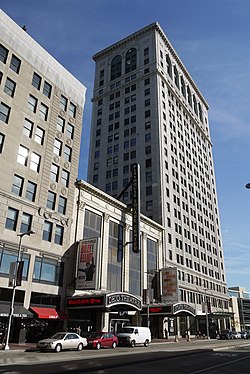PlayhouseSquare
|
Playhouse Square
|
|

|
|
| Location | 2067 E. 14th St.; 1422, 1501, 1515, 1621 Euclid Ave., Cleveland, Ohio |
|---|---|
| Coordinates | 41°30′3″N 81°40′51″W / 41.50083°N 81.68083°WCoordinates: 41°30′3″N 81°40′51″W / 41.50083°N 81.68083°W |
| Built | 1921 |
| Architect | Rapp and Rapp |
| Architectural style | Late 19th and 20th Century Revivals, Classical Revival, Other |
| NRHP Reference # | 78002041 |
| Added to NRHP | October 5, 1978 |
Playhouse Square is a theater district in downtown Cleveland, Ohio. It is the largest performing arts center in the United States outside of New York. (Only Lincoln Center in New York City is larger.) Constructed in a span of 19 months in the early 1920s, the theaters were subsequently closed down, but were revived through a grassroots effort. Their renovation and reopening helped usher in a new era of downtown revitalization in Cleveland, and was called "one of the top ten successes in Cleveland history."
Following World War I, local developer Joseph Laronge, who had previously opened the Stillman movie house on East 12th street, envisioned a row of theaters on Euclid Avenue between East 14th and East 17th streets. Laronge and New York City business magnate Marcus Loew, among others, founded a partnership called Loew’s Ohio Theatres to develop the area.
The organization’s first two theaters, the Ohio and State, were designed by eminent architect Thomas W. Lamb in the Italianate style. It was considered essential for the theaters' marquees to face Euclid Avenue, but because of space constraints the State Theatre was built at the back of the lot, although its lobby shares the Euclid frontage with the Ohio Theatre. Construction began in 1920, and the pair opened in early February 1921.
Across Euclid Avenue, Charles A. Platt's Hanna Theatre, part of the Hanna Building complex, opened in late March 1921. Although the theater faces East 14th Street, it is still part of Playhouse Square. It was named for the prominent Cleveland Senator Mark Hanna.
...
Wikipedia



